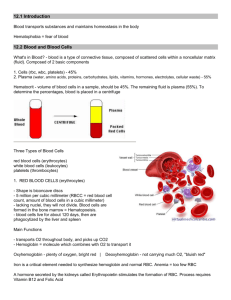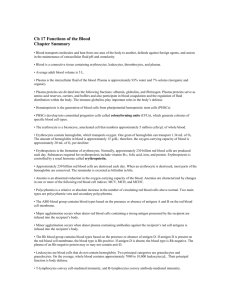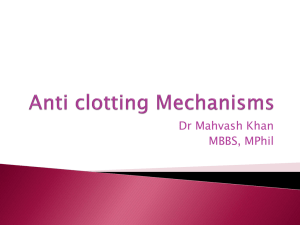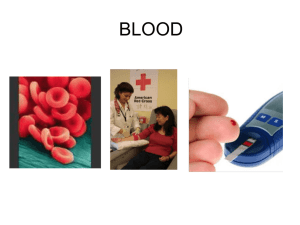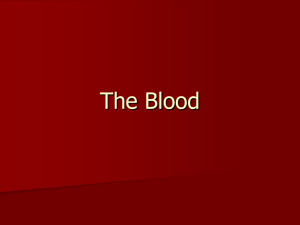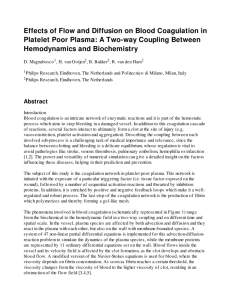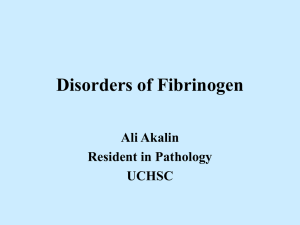HUMAN PHYSIOLOGY AND ANATOMY PRACTICE TEST 1
advertisement
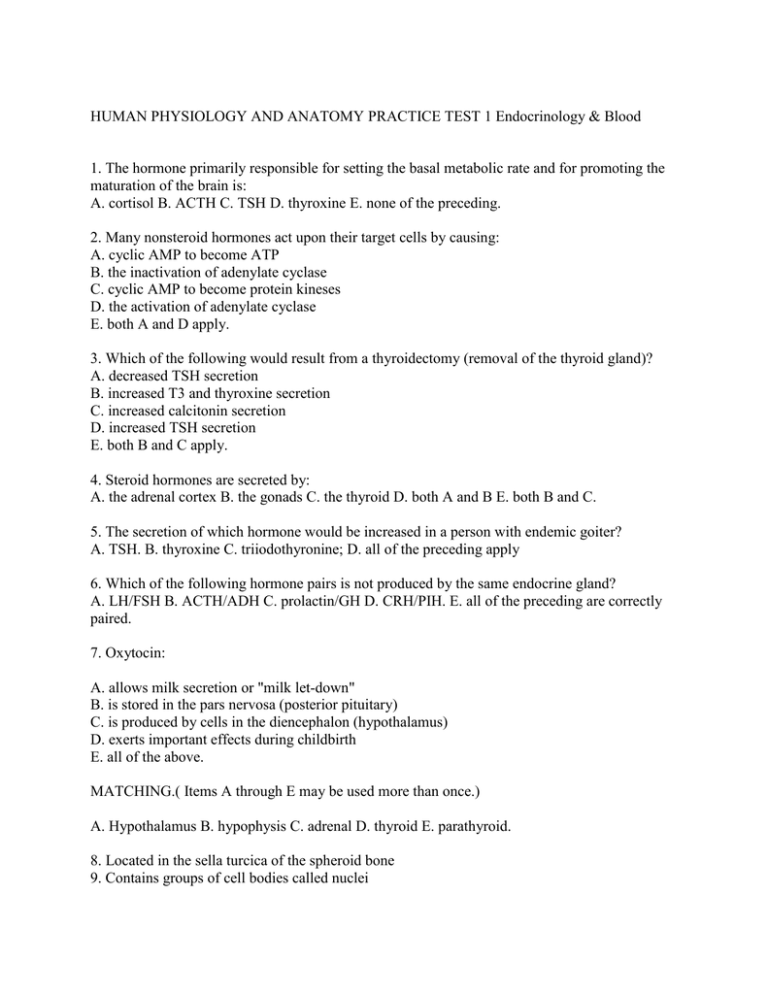
HUMAN PHYSIOLOGY AND ANATOMY PRACTICE TEST 1 Endocrinology & Blood 1. The hormone primarily responsible for setting the basal metabolic rate and for promoting the maturation of the brain is: A. cortisol B. ACTH C. TSH D. thyroxine E. none of the preceding. 2. Many nonsteroid hormones act upon their target cells by causing: A. cyclic AMP to become ATP B. the inactivation of adenylate cyclase C. cyclic AMP to become protein kineses D. the activation of adenylate cyclase E. both A and D apply. 3. Which of the following would result from a thyroidectomy (removal of the thyroid gland)? A. decreased TSH secretion B. increased T3 and thyroxine secretion C. increased calcitonin secretion D. increased TSH secretion E. both B and C apply. 4. Steroid hormones are secreted by: A. the adrenal cortex B. the gonads C. the thyroid D. both A and B E. both B and C. 5. The secretion of which hormone would be increased in a person with endemic goiter? A. TSH. B. thyroxine C. triiodothyronine; D. all of the preceding apply 6. Which of the following hormone pairs is not produced by the same endocrine gland? A. LH/FSH B. ACTH/ADH C. prolactin/GH D. CRH/PIH. E. all of the preceding are correctly paired. 7. Oxytocin: A. allows milk secretion or "milk let-down" B. is stored in the pars nervosa (posterior pituitary) C. is produced by cells in the diencephalon (hypothalamus) D. exerts important effects during childbirth E. all of the above. MATCHING.( Items A through E may be used more than once.) A. Hypothalamus B. hypophysis C. adrenal D. thyroid E. parathyroid. 8. Located in the sella turcica of the spheroid bone 9. Contains groups of cell bodies called nuclei 10. Located on the superior border of each kidney 11. Contains two structures: adeno- and neurohypophysis 12. Located on the posterior surface of the thyroid gland 13. Contains an outer cortical region and an inner medullary region 14. Located inferior to the larynx 15. Contains chromaffin cells which produce catecholamines 16. Produces releasing and inhibiting hormones 17. Produces calcitonin 18. Contains oxyphil and chief cells 19. It secretes some androgens 20. Contains chromophil and chromophobe cells. Multiple Choice. Choose the best answer. 21. A tumor of the beta cells of the pancreatic islets would probably affect the body's ability to: A. lower blood glucose level B. lower blood calcium level C. raise blood calcium level D. raise blood glucose level E. raise blood sodium level. 22. Removal of the adenohypophysis would affect all except: A. adrenal cortex B. adrenal medulla C. ovaries D. mammary glands E. thyroid gland. 23. Which hormone stimulated the production of erythrocytes in myeloid tissues? A. GH B. progesterone C. ICSH D. ADH E. none of the preceding. MULTIPLE CHOICE: Choose the best answer. 29. Which of the following is an agranular leukocyte? A. eosinophil B. neutrophil C. basophil D. monocyte E. both B and D 30. Stem cells that give rise to all formed elements of blood are called: A. megakaryoblasts B. erythroblasts C. reticulocytes D.hemocytoblasts E. megakaryocytes. 31. Hemostasis involves: A. platelet plug formation B. vasodilation C. conversion of fibrin to fibrinogen D. all of the preceding 32. Antibodies against both type-A and type-B antigens are found in the plasma of a person who is: A. type A B. type B C. type AB D. type O. 33. Which is the most abundant plasma protein? A. gamma globulin B. alpha globulin C. albumin D. beta globulin. 34. Which of the following blood proteins is not produced in the liver? A. gamma globulin B. alpha globulin C. albumin D. beta globulin E. fibrinogen 35. The proteins that attack foreign proteins and pathogens are called: A. alpha globulins B. albumins C. beta globulins D. fibrinogens E. none of the preceding. MATCHING: (Items A through E may be used more than once.) A. neutrophils B. monocytes C. eosinophils D. platelets E. basophils 36. Produced from megakaryoblasts. 37. Phagocytose antigen-antibody complexes. 38. Able to kill certain larval parasitic worms. 39. Largest leukocyte. 40. A cell fragment. 41. Leave blood vessels and transform into macrophages. 42. Nonnucleated structures. 43. Least abundant leukocyte 44. Contain ADP and thromboplastin A2. 45. Granules have an affinity for acidic stains 46. Some of the contained granules contain heparin 47. Granules have an affinity for basic stains 48. Also called thrombocytes MULTIPLE CHOICE: Choose the best answer. 49. Blood plasma pH is maintained at: A. (7.0 to 7.3) B. (7.2 to 7.4) C. (7.35 to 7.45) D. (7.4 to 7.55) E. (5.0 to 5.5) 50. Which of the following is removed from plasma to form serum? A. albumin B. water C. fibrinogen D. globulin E. vitamins 51. Which of the following substances can be added to a test tube to prevent blood from clotting A. citrate B. EDTA C. heparin D. all of the preceding E. both A and C. 52. Which enzyme begins digesting the fibrin strands and eroding the foundation of the blood clot? A. plasmin B. thrombin C. prothrombin D. thromboplastin E. none of the preceding. PRACTICE TEST 1- ANSWERS To fully take advantage of this practice test it is recommend that you look carefully at the incorrect answers as well. Determining why answers are incorrect will increase your understanding of the material - often as much as finding the information that supports the correct answer. Question# 1 2 3 4 5 6 7 8 9 10 11 12 13 14 15 16 17 18 19 20 21 22 23 24 25 Answer D D D D A B E B A C B E C D C A D E C B A B E C E Question# 26 27 28 29 30 31 32 33 34 35 36 37 38 39 40 41 42 43 44 45 46 47 48 49 50 Answer A D B D D A D C A E D C C B D B D E D C E E D C C Question# Answer 51 D 52 A The second most numerous type of white blood cell within the blood is the: a. neutrophil b. monocyte c. lymphocyte d. leucocyte Which of these formed elements in the blood play an important role in blood clotting? a. neutrophils b. basophils c. platelets d. lymphocytes Blood plasma is made up mostly of: a. b. formed elements water c. plasma proteins d. hemoglobin The most abundant of the plasma proteins are the: a. albumins b. hemoglobins c. gamma globulins b. clotting proteins When red blood cells wear out, the iron is saved, and the remainder of the hemoglobin is: a. b. c. d. also saved excreted as bile pigments rearranged into gamma globulins broken down by plasmin Stem cells that give rise to all formed elements of blood are called: a. a. b. c. d. megakaryoblasts erythroblasts reticulocytes hemocytoblasts megakaryocytes. Hemostasis involves: a. b. c. d. platelet plug formation vasodilation conversion of fibrin to fibrinogen all of the preceding Which enzyme begins digesting the fibrin strands and eroding the foundation of the blood clot? a. plasmin b. c. d. e. thrombin prothrombin thromboplastin none of the preceding. Dissolution of a fibrin clot on the blood vessel wall requires the action of: a. b. c. d. tissue plasminogen activator (tPA) and plasmin. thrombin and thrombomodulin. antithrombin III and heparin. plasmin and alpha2-antiplasmin. Receptors stimulated by changes in the concentration of ions in blood plasma would be classified as: a. proprioceptors b. chemoreceptors c. thermoreceptors d. mechanoreceptors The action of Factor VIIIa is: a. to catalyze, in a complex with tissue factor, the activation of Factors IX and X. abrogated in hemophilia b. to serve as a receptor and "cofactor" for Factor IXa. c. directly dependent on Vitamin K. d. to crosslink and stabilize the fibrin clot. Formation of the fibrin clot involves all of the following EXCEPT: a. b. c. d. chains. e. formation of covalent crosslinks between fibrin units via Factor XIIIa. spontaneous aggregation of fibrin units in a staggered, overlapping array. trapping of red blood cells, white blood cells and platelets in the final clot. cleavage and removal of N-terminal, negatively-charged peptides from each of the three fibrin proteolytic action by thrombomodulin to cleave fibrinogen.
